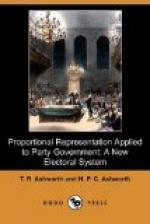+Continual Change in Electoral Boundaries.+—The irregular growth of population necessitates a periodical revision of the electoral boundaries of single-membered electorates. Owing to the influence of vested interests, this is generally effected in an arbitrary manner; and the glaring anomalies only are rectified. We have in Victoria at the present day some country electorates with 6,000 electors on the rolls and others with only 1,500. An elector in the latter has four times the voting power of an elector in the former. The process of alteration of the boundaries offers great temptation to unfairness; and in American politics the opportunity is taken full advantage of by a practice which has received the name of the gerrymander. In his work on “Proportional Representation” Professor Commons writes:—
It is difficult to express the opprobrium rightly belonging to so iniquitous a practice as the gerrymander; but its enormity is not appreciated, just as brutal prize-fighting is not reprobated providing it be fought according to the rules. Both political parties practise it, and neither can condemn the other. They simply do what is natural: make the most of their opportunities as far as permitted by the constitution and system under which both are working. The gerrymander is not produced by the iniquity of parties, it is the outcome of the district system. If representatives are elected in this way there must be some public authority for outlining the districts. And who shall be the judge to say where the line shall be drawn? Exact equality is impossible, and who shall set the limit beyond which inequality shall not be pressed? Every apportionment act that has been passed in this or any other country has involved inequality; and it would be absurd to ask a political party to pass such an act and give the advantage of the inequality to the opposite party. Consequently, every apportionment act involves more or less of the gerrymander. The gerrymander is simply such a thoughtful construction of districts as will economize the votes of the party in power by giving it small majorities in a large number of districts, and coop up the opposing party with overwhelming majorities in a large number of districts. This may involve a very distortionate and uncomely “scientific” boundary, and the joining together of distant and unrelated localities into a single district; such was the case in the famous original act of Governor Gerry, of Massachusetts, whence the practice obtained its amphibian name.[6] But it is not always necessary that districts be cut into distortionate shapes in order to accomplish these unjust results. (pp. 49, 50.)
He illustrates a gerrymander which actually made one Democratic vote equal to five Republican votes. We have quoted this description of the methods of the gerrymander not so much because the evil has attained any magnitude in Australia as because it offers a warning of the probable result of adopting the single-membered district system for our Federal legislature.




